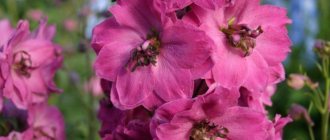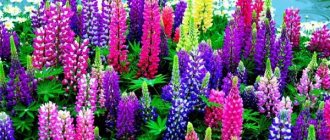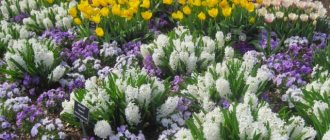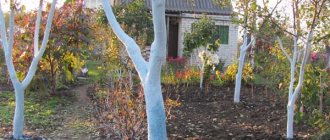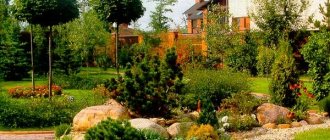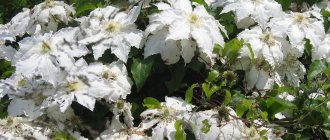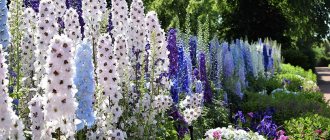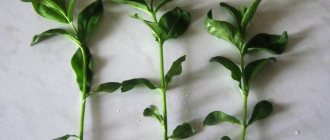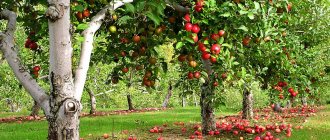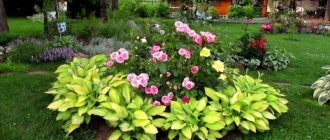- February 28, 2019
- Flowers
- Anastasia Efremenkova
Delphinium is considered a herbaceous plant and is part of the Ranunculaceae family. In addition to the main name, it also has others: spur, larkspur. Many people are interested in growing delphinium from seeds, but more on that a little later.
Delphiniums are either perennial or annual, and there are about 450 species in total. Moreover, the first ones account for only 40. This plant is most common in China, the tropics of Africa, and in Southeast Asia. It is believed that the flower got its name due to the fact that its unopened bud resembles the head of a dolphin. But this is just one version. According to another, the name comes from the city of Delphi, in Greece. They say that previously in this locality this flower could be found in literally every flowerbed. Almost every gardener says that this plant will decorate any garden. Next, we’ll look at how to grow a delphinium from seeds and organize its care.
Features of the flower
Experienced flower growers unanimously insist that growing delphinium on your own plot is not so easy and you need to study this flower well before planting it in flower beds.
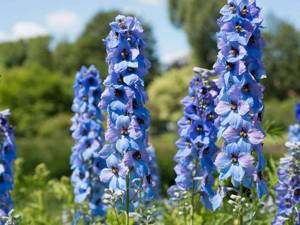
The main attention should be paid to the landing site. In the first half of the day there should be sun on the site, but in the afternoon it will be better if partial shade occurs in this place. Also, in this place there should be no strong wind, much less drafts. It is good if the site is located on a slight hill so that water does not stagnate in the ground. Otherwise, this will lead to rotting of the plant. Immediately after planting, the delphinium should be mulched. For this, it is customary to use peat or humus.
Periodically you will have to change the place where the plant is planted. Delphinium needs transplants once every 5-6 years. If you chose the Pacific species, then this procedure will have to be carried out even more often - once every 3-4 years. During transplants, you can safely begin propagating the plant by dividing the bush.
The delphinium stems are quite tall, so they need to be constantly tied up to prevent them from being broken by the wind. Moreover, this will have to be done more than once per season. It is also worth noting that the delphinium is afraid of some insects that often attack it, and can get powdery mildew.
If all these conditions do not frighten you, and you decide to start growing this plant, then in June and August you will have the opportunity to admire its beautiful flowering.
Delphinium propagation
Perennial delphinium is propagated by cuttings, dividing the bush, and in shifts. When propagating using the seed method, there are many subtleties that will need to be taken into account. When purchasing grains, some encounter poor germination. It is safer to collect grains with your own hands. The accumulated seeds are stored in glass containers in a cool place.
Dividing the bush
This is a very simple generation method. Bushes aged 3–4 years are mainly suitable for this. It is preferable to divide the spur bush in the spring, at the stage of leaf growth. But it is possible to do this in the autumn, although it is somewhat more difficult to measure the appropriate period for this. The extracted rhizome of the spur is carefully divided so that a single section has at least 1 shoot, 1 dormant bud and a huge number of roots.
As a rule, delphinium propagated by crushing a bush blooms already in the coming year.
Kinds
As already noted, delphiniums are either annual or perennial. The first ones should be considered first. The most popular among them are:
- Delphinium field. This is a fairly tall plant that can reach a height of two meters. The inflorescences can have different flowers: simple and double with a variety of shades. The most common colors are: lilac, pink, white, blue. This species appeared in culture a very long time ago - in 1572.
- Delphinium of Ajax. This is a hybrid species. It combines delphinium dubious and oriental. The selection was successful and combined the best qualities of the mother species. The stem is shorter than that of the field one, can reach one meter in height, the leaves can be called sessile, they are strongly dissected, the inflorescences look like ears of ears and can reach a length of up to 30 centimeters. The color range is quite wide: purple, pink, blue, white, red, blue. There are varieties not with ordinary, but with densely double buds. Delphinium Ajax differs from other species in that it blooms right up to the onset of frost.
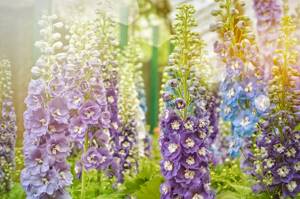
Next, you should pay a little attention to perennial plant species (their photos can be seen below). It is worth noting that growing perennial delphinium from seeds is quite acceptable and is successful. Such species became widespread only in the 19th century. Annual plants were taken as a basis. As a result of crossings, the first and one of the best species were obtained - tall and large-flowered delphinium. Later, one French breeder, Victor Lemoine, bred double perennials with purple, blue, and lavender flowers. They are very popular with gardeners for their stunning appearance. Modern perennials have a very wide range of colors - more than 800 shades. There are a wide variety of varieties that differ from each other not only in the shade of the flowers, but also in their shape and appearance.
Perennial delphiniums
The cultivation of perennial plants in culture began in the 19th century: breeders based on Delphinium tall and Delphinium grandiflora created the first hybrids (Delphinium belladonna, Delphinium beautiful and Delphinium Barlow) through crossing, and then the Frenchman Victor Limoine created terry varieties of perennials in lavender, blue and purple shades , called beautiful or “hybrid”, and then renamed “cultural”. Now perennial delphiniums have more than 850 colors in their color range. Among these plants, there are low-growing, medium-height and tall varieties with semi-double, simple, super-double and double flowers with a circumference of 3-10 cm.
Hybrid perennial plants are divided into groups according to their place of birth. The most popular are Scottish terry, New Zealand and Marfin terry delphiniums, which were named after the Marfino collective farm. All varieties have their own differences and advantages. Marfinskie, for example, have good resistance to frost and are highly decorative; these plants have semi-double and large flowers with contrasting and bright eyes. But it is very difficult to grow the Marfinsky variety from seeds, since the seeds do not retain varietal properties.
The New Zealand species, bred relatively recently, is characterized by large growth (up to 2.3 m), large double or semi-double buds (8-10 cm in circumference), and some varieties have corrugated petals. These hybrids are frost-resistant, disease-resistant, excellent for cutting, durable, and it is for this reason that they are now the most popular.
Tony Coakley is considered the creator of Scottish hybrid perennials. These varieties are characterized by rather dense inflorescences of double and super-double buds, often numbering more than 60 petals. With a bush size of 1.2-1.6 m, the inflorescence can reach a length of 85 cm! “Scots” have a large palette of colors, are durable, easy to care for and perfectly retain varietal properties during propagation by seeds.
Growing delphinium from seeds
Growing plants from seeds is one of the simplest and most affordable ways to propagate them for modern gardeners. This is an excellent option for beginners and those who do not have the opportunity to spend a lot of time on floriculture. For those who want to grow delphinium from seeds, it is worth noting that such propagation will not only save money on the purchase of planting material, but will also become quite an exciting activity. Delphinium can reproduce not only by seeds, but also by buds, dividing the bush, and cuttings.
It is necessary to sow delphinium seeds at the end of February. Please note that for planting they must only be freshly picked or stored in the refrigerator beforehand. If the delphinium seeds were lying in a dry and warm place, then they have lost their germination and you don’t even have to try to sow them, since you won’t get any germination anyway.
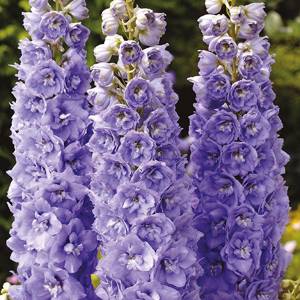
How to propagate delphinium by seeds: planting and care when growing seedlings
During seed propagation, parental properties are not transmitted, so you yourself will become a breeder and may well obtain hitherto unknown varieties. Freshly collected seeds (they ripen in August, for this you need to leave the faded clusters on the stems) are immediately sown in the greenhouse. Shoots appear in the fall and can freeze in the spring, so they should be covered with spruce branches for the winter. To avoid fussing with this, it is better to sow the seeds right before winter (late November). In the spring, seedlings appear; when growing delphiniums, seedlings should be planted 2-3 plants into one container or thinned out according to a 10x10 cm pattern and planted in place in August according to a 40x40 cm pattern.
Then expose it to light in a warm room. There is a nuance. Since delphinium seeds are very small, they are not sprinkled with soil when sowing. The moistened soil is compacted, the seeds are scattered over the surface and covered with film until shoots appear. Or, when sowing seedlings at home in March, snow is added to the soil surface in containers and the seeds are sown on the snow. Once melted, it will draw the seeds halfway into the soil.
To grow delphinium seedlings from seeds, place the container in a plastic bag and tie it. The seedlings are watered through a syringe, the needle of which is inserted into the ground. When growing flowers from seeds, when the delphiniums grow and begin to fall to one side, you need to rake the soil to them with a match.
When the frosts have passed, when caring for delphiniums, the seedlings can be moved either to the school until next spring, or directly to the place
But here it is important not to let the weeds clog them or the soil to dry out
Disinfection process
Before planting seeds in the ground, they should be completely disinfected. This is necessary in order to prevent the development of diseases or the appearance of insects in the roots. The seeds should be placed in a gauze bag and dipped in a solution of potassium permanganate for twenty minutes. If you do not have this product or you do not trust this method, then you can use a fungicide. Here the solution is already prepared according to the instructions. After this, the seeds along with the bag are washed under running cold water, and then placed in an epin solution for a day. For 100 ml of water you will need no more than 3-4 drops. After this time, the seeds should be dried a little so that they do not stick together.

Delphinium varieties with photos
Today there are more than four hundred varieties of spurs with different colors. They can be pink, white, purple, blue. The following varieties are most popular among gardeners:
del'finium dark blju bljek bi
Delphinium Sky Blue White Bee is a bush up to 180 centimeters high with palmately dissected leaves and sky-blue flowers with a white center. Its flowering begins in mid-summer and continues until autumn. Suitable for cultivation in many regions of Russia.
“Pink Butterfly” - a low plant up to one meter high, distinguished by bright pink flowers similar to a flying butterfly.
'Princess Caroline' is an attractive variety with soft pink flowers up to 10 cm in diameter. The bush can grow up to 2 meters in height.
“Snow lace” - a bush up to one and a half meters high has a luxurious appearance. Delicate white flowers bloom on it, exuding a pleasant, subtle aroma.
The rare-flowering variety grows only 75 cm in height. Its flowers are located only at the top of the stem. Flowering occurs from July to August.
Delphinium Leroy grows to almost one and a half meters and blooms with snow-white flowers with a greenish tint, from which a scent reminiscent of vanilla emanates.
Terry varieties of larkspur appeared thanks to the work of breeders. They can have a height of 120 to 200 cm and double flowers with a diameter of up to 7 cm. The flowers have two rows of petals and are purple, blue, lilac-pink, lilac, white or lilac in color.
You will be interested to know: What flowers can be sown in the ground in June: name, photo, description
The Belladonna variety is interesting in that instead of candle-like inflorescences, it produces drooping panicle-shaped inflorescences.
It is impossible to list all varieties of larkspur, since there are so many of them, but planting, growing and caring for them in open ground is approximately the same.
Soil preparation
To prepare the soil for planting delphinium, you should take equal parts of humus, peat, garden soil, and also half of washed sand. All this should be mixed and sifted. To make the soil more moisture-absorbing and loose, you should add perlite to it. For five liters of soil mixture you will need half a glass of the substance.
The mixture should be heated in a water bath for an hour to get rid of fungal spores and seeds of various weeds. After this, you can safely fill the containers in which you plan to plant the seeds with soil mixture. At the same time, it should be compacted a little. Next, we’ll find out when to plant delphinium seeds.
Landing rules
Now you can safely start planting delphinium seeds. They should be distributed over the surface of the soil. Don’t forget to immediately write down or label the containers with the name of the variety and the date the seeds were planted. The seeds should also be sprinkled with earth on top, but not more than 3 mm. This is required so that after watering they do not float. Next, you need to water the crops with cold and always boiled water, cover the containers with a transparent lid or glass to create a greenhouse effect, and cover the top with black film. This is necessary so that the delphinium seeds germinate better.
The container in this form is placed on the window closer to the glass. Seeds germinate best at temperatures from plus ten to plus fifteen degrees.
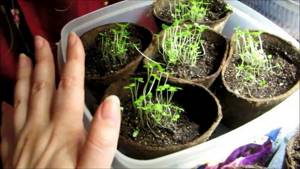
You can try to increase germination by placing the containers in the refrigerator for three days or on a glazed balcony or loggia. Then return the seed containers to the window. This procedure is called stratification. If this is done, the first shoots can be observed within a week and a half. It is important not to miss this moment in order to remove the black film in time. You also need to monitor the soil so that it does not dry out, so lift the film and glass from time to time and moisten it with a spray bottle. This will also be an excellent time to ventilate the seeds.
Planting delphinium in open ground
Choosing a landing site
Delphinium loves open areas with excellent light, but due to the frequent influence of open sunlight, there is a risk that the picturesque flowers have a good chance of fading. It is also necessary to understand that the larkspur plant is tall and a powerful wind has the ability to break it. This means that when choosing a place to plant the spur, make sure that it is protected from the hot midday rays of the sun and powerful winds. It is not recommended to select low-lying places where moisture will linger.
Landing
The delphinium planting plan will depend on the scale and species you choose. In mass plantings, the gap between plantings is usually from 35 to 50 cm. If the soil in the selected area is poor, then it must be normalized by adding greenhouse soil or a mixture of soil and compost to each planting hole. Additionally, it is recommended to add a handful of wood ash or ashes. This will not only enrich the soil, but will also prevent certain diseases from developing.
For the best adaptation of the seedlings, it is recommended to cover each of them with a transparent jar or cut plastic bottle. After a couple of days, when the spur seedlings have taken root very well and begin to grow, you can remove the covers.
What to do with seedlings
It is quite easy to distinguish healthy sprouts from the rest. They are dark green in color, quite strong, and have pointed cotyledons. With the appearance of the third leaf on a young plant, you can safely plant it in larger pots (200-300 ml). Next, the seedlings should be in a room where the temperature is not lower than 20 degrees.
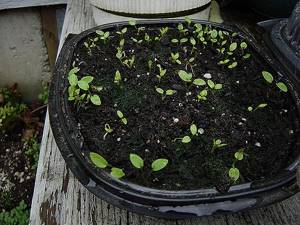
Monitor the condition of the soil. It should always be loose and breathable, it should be watered moderately, otherwise a “black leg” may appear, which leads to the complete death of the diseased plant.
In May, you can begin to accustom the seedlings to fresh air, so there is no need to remove the pots from the windowsill while the room is being ventilated. Also, seedlings should spend some time every day in the sun. Before planting in open ground, one or two feedings should be carried out with a break of 2 weeks. Agricol and Mortar are excellent for this. Make sure that the solution does not get on the leaves.
How to determine that delphinium seedlings can be planted in open ground? Quite simple. Pay attention to the lump of earth - if it is already completely entwined with roots, then it is time to transplant to fresh air. Don’t worry, it won’t be difficult to remove the seedlings along with the soil from the pot. In this case, the root system will remain intact.
Delphinium perennial plant
Delphinium is a legume, tuberous herbaceous plant. This tall herbaceous flower has a distinct shape. Each “candle” has a rosette of large leaves at the base, the top is crowned with an inflorescence of large flowers. A single flower has a size of up to 2 cm in diameter. The root system is a cluster of tubers.
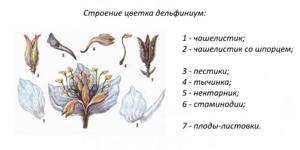
The luxurious, lush crowns of the plant create a riot of colors and delicate shapes. Delphinium is good for creating compositions in the spirit of a wild garden; it can be included in any ensemble of classical garden design. The height of the “candle” reaches 2.5 meters; some decorative low-growing varieties (up to 0.5 m) make it possible to form a cascade of tall and medium-sized plants.
Flower shades vary:
- blue;
- violet;
- pink;
- white;
- lilac;
- bright red.
The main popular varieties of delphinium are:
- Delphinium Leroy;
- Kashmiri;
- Pyramidal;
- Blue;
- Delphinium Bruno;
- High;
- Terry;
- Labiate;
- Rarely colored;
- Short-spur.
The varieties differ in height, color, as well as some features during care. In general, the plant is unpretentious to conditions and easily tolerates the harmful effects of cold and drought.
Planting seedlings with seeds
We have already learned when to plant delphinium seeds for seedlings, and now we should pay attention to how to plant these seedlings in the ground. Let us remind you that the place for growing, as mentioned earlier, should be sunny only in the first half of the day.
You should prepare in advance for planting seedlings. Dig holes at a distance of 60-70 centimeters from each other. Their diameter should be 40 centimeters and their depth 50 centimeters. At the bottom of each hole you should place half a bucket of humus, as well as a glass of ash and two tablespoons of complex fertilizer. Be sure to mix it all with the soil so that the fertilizer does not come into contact with the roots. After this, you need to make a small depression to place the seedling in it, compact the soil around it and water the beds.
After planting, it is better to keep the seedlings under a glass jar or plastic bottle for some time so that they get used to the new environment. Monitor the process when the delphinium grows to immediately remove this shelter.
Delphinium care
The delphinium grows in one place for at least 3 years.
In order for it to please the eye with its flowering all this time, it needs to be properly cared for. There are different opinions about the unpretentiousness of this plant.
Some consider it a rather unpretentious flower because it can withstand long-term drops in temperature. Others are a complex plant with a huge number of diseases.
If you water, fertilize and replant plants on time, there shouldn’t be any problems. Of course, the success of cultivation depends on many objective factors. For example, on the composition of the earth. Delphiniums grow best on loam. On sandy loam soils the flower will be smaller and paler.
How to water and feed
Delphinium loves water, but excess moisture negatively affects its development. It begins to hurt and rot. It is necessary to water abundantly, especially during dry periods. But at the same time, make sure that the water does not stagnate.
Feeding is done several times. Before planting, the soil is prepared by adding fertilizers, then, after planting, the delphinium is not fed for a month and a half. The soil has enough everything for full development, and excess fertilizer during this period is especially harmful, since the plant must take root properly.
After this, we feed with complex mineral fertilizers about once a month. During the period of budding, flowering and after the plant has flowered, we feed it with complex fertilizer or phosphorus and potassium fertilizer. To do this, take a tablespoon of superphosphate and a tablespoon of potassium sulfate into a bucket of water.
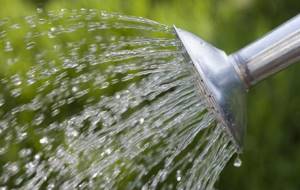
Delphinium after flowering
After flowering, we fertilize (we do not include nitrogen fertilizers). Then we cut off all the inflorescences. If you want to get your own seeds, then you need to leave the inflorescence. But next year the mother plant will not bloom so profusely, since the formation of seeds takes a lot of nutrients.
In autumn you need to cut off the entire above-ground part. After this, the protruding stems must be covered with clay or caps placed on them to prevent water from getting there. The stems of delphiniums are hollow and due to stagnation of water they begin to rot. This process occurs unnoticed at first. But as a result, you can lose the entire plant.
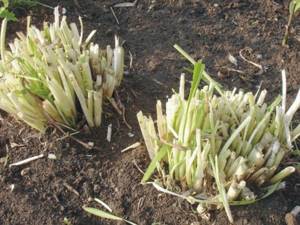
Caring for delphinium in the second year
In the spring of next year, after the shoots appear, the delphinium is shed generously and then fed with mullein or azophoska. Leave 2-3 stems on the bushes, remove the rest.
Some people grow delphinium in one place for 3 years, others for 5-6 years. It all depends on what kind of soil you have. On well-fertilized loams or clay soil, perennial plants can be left longer. And on sandy or sandy loam, you need to change the place every three years, as the soil is quickly depleted.
How to properly organize care
Growing delphinium from seeds requires some attention even after planting in the ground. When the height of the young shoots reaches 10-15 centimeters, the first feeding should be done using cow manure. The solution is prepared according to the proportion: 1 bucket of manure per 10 buckets of clean water - this should be enough for 5 large delphinium bushes.
- Be sure to remove all weeds from the garden bed and loosen the soil to allow air to reach the roots.
- After this, lay a layer of mulch three centimeters from the ground. For this, it is best to use peat and humus.
- When the stems double in size, you can safely begin thinning the bushes.
- For one bush, it will be enough to leave 3-5 stems. This way you will get beautiful and large inflorescences.
- Shoots should be removed from the inside of the bush, which, in your opinion, are the weakest. You need to break off and cut off unnecessary shoots at the very base of the bush. Such actions will help protect the plant from diseases and will also have a positive effect on air circulation.
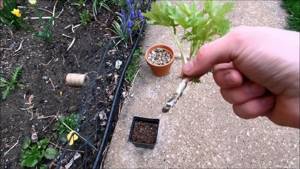
Cuttings do not have to be thrown away. If they are not hollow and you managed to separate them along with the heel, then you can try to root them. The cut must be treated with heteroauxin and a tablet of crushed coal, then the cutting is pinned to a mixture of peat and sand and covered with cling film. After about five weeks, the cutting should take root, and after another two weeks it can be safely planted in the garden beds.
Reproduction
In addition to seeds, there are other ways to propagate the plant. In spring or early autumn, when the delphinium has already bloomed, you can try to divide it.
Age – from 8 years. Carefully dig up the bush and clear the root from the soil. Cut the shoots. There are growth points on them, it is better not to touch them at all. Each cut is greased with charcoal. The delenki are planted in a new place and covered with earth mixed with humus, ash, and compost. Don’t be confused by the fact that the transplanted plant will hurt and dry out during the first months.
All delphiniums tolerate landing extremely difficult.

Propagation of delphinium by cuttings
Propagation by cuttings is used extremely rarely due to its labor intensity. Planting material – shoots 6-8 cm long, cut from young specimens. They are treated with growth stimulants and planted in fertile soil. Fertilizer is applied after 2 weeks. It is advisable to do cuttings in the spring, so that by the beginning of autumn you will have full-fledged plants ready for wintering outside.
Growing season
During the growing season, delphinium needs liquid. Each plant “drinks” about 60 liters of water. Therefore, once a week you should pour at least two buckets of water under the bush. After watering, you need to let the soil dry a little, and then loosen it and remove any existing weeds. When inflorescences begin to form on a plant, it desperately needs water, especially if it is very hot outside at that time. At this point, areas without flowers may appear on the inflorescences.
This can only be avoided if there is abundant watering, as well as if fertilizing is carried out using potassium-phosphorus fertilizers: 20 grams of the substance must be diluted in one bucket of water and one liter poured under each bush.
Delphinium thinning
In the second year of the growing season, the delphinium produces a lot of shoots, therefore, in order for it to bloom profusely with large flowers, it is necessary to thin out the bush of the plant. This is done in the spring when the stems reach 20-40 cm. 5-10 (depending on the variety) strong shoots are left in the bush. For better air circulation, first remove unproductive stems in the inner part of the bush.
Instead of such thinning, you can cut off excess growth buds in the fall. As a result of this procedure, nutrition in the spring will flow to the remaining buds, which will develop at an accelerated pace. If the shoots are removed with the heel (a piece of rhizome), then they can be used as cuttings for propagating larkspur.
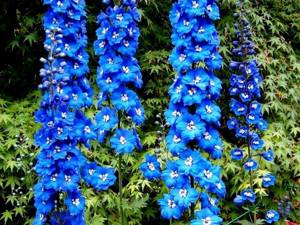
Diseases and pests
The second half of summer is dangerous because powdery mildew begins to appear on plants. This is a fungal disease that affects many garden plants. If the delphinium gets sick, its leaves will become covered with a white coating, which will turn brown over time. If the gardener does not react in time, the plant will completely die. To combat powdery mildew, it is common to use drugs such as Topaz or Fundazol. Treatment is carried out at the first signs of illness.
You can also find black spots on the leaves of the plant, which appear mainly in the lower part. This disease is called black spotting. It can only be overcome at the initial stage. To do this, you need to spray the plant twice with a special solution, which includes a tetracycline tablet diluted in one liter of water. Delphinium also does not ignore ring spot. During this disease, the leaves are covered with yellow spots. This disease is viral and it is useless to fight it. The only correct solution is to remove the affected plants from the beds before all the specimens are infected.
Many viruses are transmitted by insects, including aphids. To combat it, flowers should be treated with Actellica or Karbofos solution. In addition to aphids, delphinium can be affected by pests such as delphinium flies and slugs. The first can be defeated with the help of insecticides, while the second are afraid of the smell of bleach. Therefore, you can simply place small containers with its solution on the flowerbed, and the slugs will be afraid to approach.
So we found out when to plant delphinium from seeds. Growing a plant, as can be seen from the article, is not at all difficult, but even an exciting activity.
